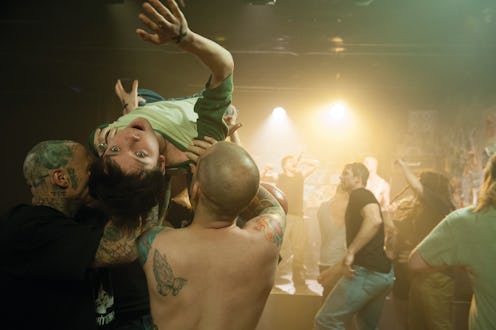
In my opinion, the best films use highly specific settings to tell stories with universal appeal. In the case of the movie Ten Thousand Saints, that setting is New York City in the late '80s, particularly the hardcore punk scene that so many young music junkies devoted themselves to. Saints tells the story of Jude (Asa Butterfield), the child of apathetic hippie parents, living in Vermont. Jude spends his days not doing much but getting high with his best friend Teddy in a myriad of creative ways. As 1987 comes to a close, Teddy overdoses, and in the wake of the tragedy, Jude moves in with his father Les (Ethan Hawke) in Manhattan. There, he connects with Teddy's older brother Johnny (Emile Hirsch), who pulls Jude down the rabbit hole of the restrictive and passionate "straight edge" culture. So, is Ten Thousand Saints based on a true story, or any real NYC events?
Not directly. Ten Thousand Saints is actually an adaptation of a novel of the same name, written by Eleanor Henderson. The book was published in 2011 and received rave reviews from publications including The New York Times, who called Henderson's writing "fierce, devoted and elegiac." The plot and characters are works of fiction, though the setting is very real. The "straight edge" movement was still blossoming in New York City's punk club scene around the time that the film is set. To better prepare you to experience Jude's onscreen journey, here's a crash course on this moment in music history.
The Commitment
Individuals who choose to live a "straight edge" lifestyle commit to a spartan existence. No drinking, no smoking, no drugs, no casual sex. (No fun? Kidding.) And in some cases the "clean living" rules extend to exclude meat, dairy, and even worldly possessions. The counterculture was a reaction to the a substance-obsessed punk culture that saw heroes like Sid Vicious lost far too young. The Vinyl Factory explains, "The romantic “live fast, die young” mantra was increasingly becoming a grim reality, as many punks piled hard drugs on top of abundant booze, glue, and weed."
The Bands
The term "straight edge" was coined by a punk band called Minor Threat via one of their song titles. The lyrics proclaimed the band's lack of use for mood-altering substances, and struck a chord with many of their fans.
Laugh at the thought of eating ludesLaugh at the thought of sniffing glueAlways gonna keep in touchNever want to use a crutch
"Straight edge" individuals replaced all chemical and potentially harmful kinds of escape with the thrill of live music. They gathered in clubs to see bands like Minor Threat, Youth Of Today, Government Issue, and Negative FX, losing themselves in ear-splitting chords and aggressive mosh pits. Ten Thousand Saints is set primarily during the "Youth Crew" era, a resurgence of a culture that first hit the scene in the '70s.
The Clubs
In New York City, the legendary club CBGB was a mecca for hardcore punk musicians and their fans. The venue was an East Village institution from the early '70s until its shuttering in 2006. During the height of hardcore, CBGB hosted weekly Sunday matinee shows. Ralphie G of the band the Mob told the author of the book NYHC why matinees were suited for the club's "straight edge" clientele:
Hardcore with the right bands could fill a club. The drinking part was another story. That's how the idea for the matinees came about. CBGB could still keep the nights for the older, drinking crowd, but still have a venue for hardcore without eating too much into the profits.
That's some smart business, right there.
And now you're ready to immerse yourself in the heady days of hardcore punk when Ten Thousands Saints starts showing in select theaters and becomes On Demand Aug. 14.
Image: Screen Media Films; Giphy (3)